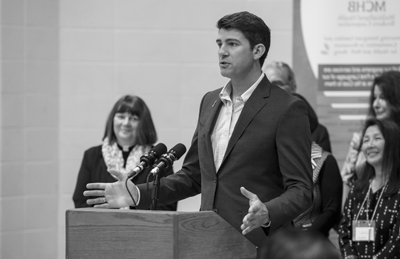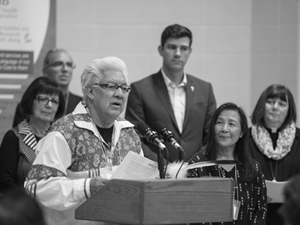November 27, 2015
Mayor Don Iveson brings the city together through an initiative that aims to end poverty within a generation
Eliminating poverty in Edmonton within a generation is an ambitious goal, but that’s exactly what the End Poverty Edmonton (EPE) initiative is aiming to do.
On September 18, more than 100 Edmontonians gathered in the McCauley School gymnasium for the release of the EPE strategy. The 56-page manifesto was compiled by the Mayor’s Taskforce to End Poverty with input from more than a dozen partner agencies, and most importantly, more than 200 community members – notably some with experience living in poverty.
The strategy highlights 28 priority recommendations, including six “game changers,” that will require all Edmontonians and orders of government to come together to end poverty in Edmonton over a generation.
“It’s about more than income or money,” Mayor Don Iveson says. “To live in poverty can refer to a loss of culture, traditions, language and spiritual connections. It’s about lost potential and lack of community or family support.”
We caught up with Mayor Iveson to chat about EPE, the challenges it faces and the hope it provides.

ANDREW PAUL: How does EPE define “poverty?”
DON IVESON: Edmontonians experience poverty when they lack, or are denied, economic, social and cultural resources to have a quality of life that sustains and facilitates full and meaningful participation in the community. This definition, I believe, is central to the EPE strategy, shaping our approach, the priorities we identified and the solutions we propose.
AP: What root causes of poverty were identified during the research process?
DI: There are four key areas of root causes – conditions that increase the probability of poverty including life stages people go through – from youth to parents to seniors; systemic barriers, personal vulnerabilities and disruptive life events.
AP: What safeguards are in place to ensure EPE’s long-term goals are achieved regardless of who is sitting on City Council and in the Mayor’s office?
DI: City Council unanimously backed the formation of the task force. City Council will be asked to approve this strategy in December 2015 and the first 10-year plan of this generational initiative in April 2016. That 10-year plan will identify a permanent home for this plan, along with sustainable resources, to support its implementation over 10 years. The steward may be a community partner or organization; we don’t know yet. As part of the Big City Charter discussions with the provincial government, we are hopeful that it will recognize that here we have already a made-in-Edmonton solution and that we can jointly partner to end poverty.
AP: The EPE strategy identifies the need to eliminate racism as a key step to eliminating poverty. How does racism contribute to poverty specifically in Edmonton?
DI: Racism has roots in the legacy and impact of colonialism for many Aboriginal peoples. For visible minorities, experiences of discrimination in seeking employment opportunities limit their opportunities for advancement.
“OUR VISION IS THAT A CHILD BORN TODAY WILL NOT LIVE IN POVERTY AS AN ADULT”
AP: How will EPE tackle the issue of unemployment to ensure that all Edmontonians earn livable incomes within a generation?
DI: Unemployment is an issue that needs the collective effort of many sectors. The business sector needs to increase recruitment and hiring of a diverse workforce such as Aboriginals and newcomers. The provincial government and professional associations need to speed up the accreditation of internationally trained professionals. We also need co-ordinated and sustained delivery for skills training for employment in the not-for-profit sector, and for financial institutions to explore creative financing options to grow social enterprises for entrepreneurs with limited access to capital.
AP: Quality and affordable childcare is a major barrier for lone-parent families trying to secure livable incomes. What has to happen to increase the capacity of affordable child care in Edmonton?
DI: Our vision is that a child born today will not live in poverty as an adult. And that one generation later, that child’s son or daughter will not be born into poverty. Child care services should be viewed within an integrated system of learning and care. Such a comprehensive system should include centre-based care, day homes, respite care and kinship care, as well as supports for stay-at-home parents and for the people outside children’s homes who work with young children.

AP: How is the city planning to address the issue of affordable public transit for Edmonton’s most vulnerable?
DI: Our strategy proposes a variety of tools to address affordable transit such as free public transportation for children 12 and under, rather than six and under today – to provide discounted or free passes for agencies to provide to youth at risk. This pilot has already begun for 100 kids for six months. And [we plan] to institute a low-income bus pass with a 60 per cent discount, consistent with the AISH pass, based on the same criteria as the City’s existing Leisure Access Program.
AP: What role would you like to see the Provincial Government play in addressing the issue of mental health and what can the City do to help?
DI: The EPE strategy was developed with the participation of provincial health representatives, health practitioners and service providers and those who have lived experience of poverty. Their recommendations centre on advocating for better ways of providing and accessing services, for increased funding and support of education programs, and for increased co-ordination and integration of children’s services.
AP: What’s the best way to approach the need for affordable housing in Edmonton?
DI: EPE believes that the community can step up and take actions where governments are slow to respond. A strategy is neededthat allows low-income communities to participate in finding solutions and taking actions on the challenges that they face every day. It means mobilizing the right people and resources to provide the tools required to enable communities to thrive locally and be part of Edmonton’s prosperity. Community development corporations can provide the infrastructure and sophistication needed to enable the community to take on these challenges by supporting the creation of affordable and supportive housing, offering job training/placement, investing in appropriate community-based business development, and creating new community-owned businesses. These corporations, as engines of development and economic opportunity, require significant start-up capital and the focused deployment of equity, debt, and grant funding.
IN CONJUNCTION WITH END POVERTY EDMONTON, ECF is committing $10 million in social impact investment for social housing projects and programs that create living wage jobs for Edmontonians experiencing poverty.
To learn more about EPE and how you can help end poverty within a generation, click here.